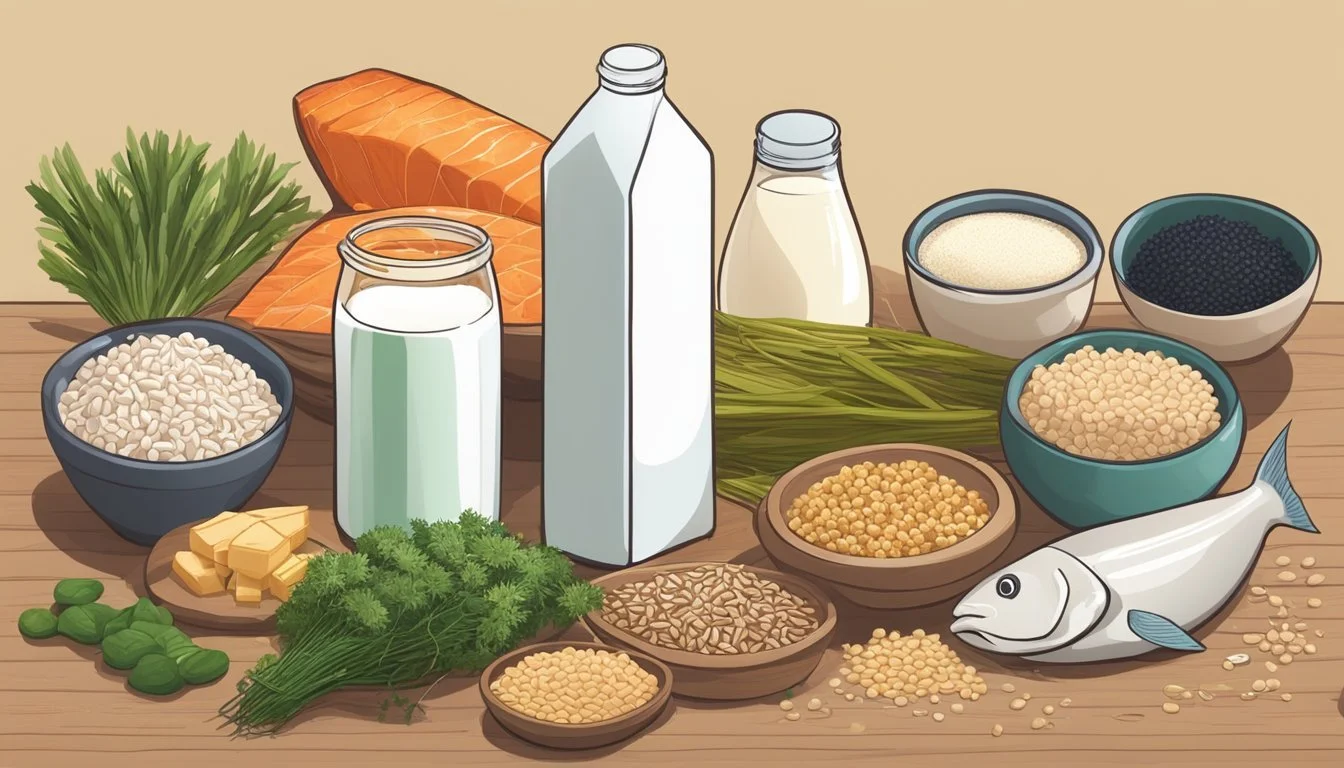How Can I Get Enough Iodine If I'm Lactose Intolerant
Alternative Sources Explained
Iodine is an essential nutrient vital for proper thyroid function, and it's commonly found in dairy products. However, for individuals with lactose intolerance, consuming dairy can lead to discomfort and health issues due to the lack of the enzyme lactase, which is needed to digest lactose, the sugar found in milk. Lactose intolerance necessitates finding alternative sources of iodine to maintain a well-balanced diet and ensure adequate intake of this crucial mineral.
There are several viable iodine sources for those who cannot consume lactose-containing foods. Seafood, such as fish, shellfish, and seaweed, are excellent sources of iodine. Additionally, iodized salt is widely available and can easily be incorporated into a variety of dishes to enhance iodine consumption. Moreover, eggs and certain plant-based foods, like prunes, are also beneficial for those looking to maintain their iodine levels without dairy products.
It's important to note that while seeking alternative sources of iodine, one should always be aware of the daily recommended intake and the potential risks of overconsumption. Overconsumption can lead to health complications just as serious as a deficiency. Consulting with a healthcare provider or a dietitian can provide personalized guidance to individuals with lactose intolerance to ensure they meet their nutritional needs without compromising their comfort or health.
Understanding Lactose Intolerance
Lactose intolerance is a common digestive issue caused by the body's inability to process lactose, the sugar found in dairy products, resulting in uncomfortable symptoms.
Definition and Causes of Lactose Intolerance
Lactose intolerance occurs when the small intestine does not produce enough enzyme called lactase, which is necessary to digest lactose, the sugar present in dairy. The undigested lactose moving into the colon instead of being processed in the small intestine leads to various symptoms.
There are different types of lactose intolerance:
Primary lactose intolerance, the most common type, is caused by a genetic predisposition where lactase production decreases with age.
Secondary lactose intolerance develops due to an injury or illness affecting the small intestine, such as celiac disease.
Congenital or developmental lactose intolerance is a rare condition where infants are born with lactase deficiency due to genetic mutations.
Symptoms and Diagnosis
The symptoms of lactose intolerance can include:
Diarrhea
Gas
Nausea
Bloating
These signs typically emerge within 30 minutes to two hours after consuming dairy. To diagnose lactose intolerance, doctors often recommend a hydrogen breath test, which measures hydrogen in the breath after consuming a lactose solution. If undigested lactose ferments in the colon, it will release hydrogen that gets detected in the breath.
Alternatively, a blood test can assess changes in blood glucose levels post lactose ingestion, and a stool acidity test can be helpful, especially for young children and infants.
Nutritional Strategies for Lactose Intolerance
Managing lactose intolerance effectively requires an understanding of how to replace dairy in the diet to maintain adequate nutrition, particularly concerning the intake of iodine.
Lactose-Free Diet Overview
Individuals with lactose intolerance often need to avoid dairy products that contain the milk sugar, lactose, which can be difficult to digest due to the lack of lactase enzyme. A lactose-free diet involves the elimination or reduction of lactose-containing foods. Fortunately, there are various lactose-free alternatives and strategies one can employ:
Substitute regular dairy products with lactose-free options, including lactose-free milk, cheese, yogurts, and ice cream.
Incorporate nondairy milk products such as almond, soy, coconut, and oat milk, which are naturally free of lactose.
Opt for dairy products that are lower in lactose, like hard cheeses and greek yogurt, which may be tolerable in small quantities.
Be aware of hidden lactose in non-dairy products such as certain baked goods, breakfast cereals, and processed meats that might use milk products in their production.
Look for foods fortified with calcium and other nutrients to ensure dietary requirements are met without lactose.
Iodine Importance and Sources
Iodine is a crucial nutrient for thyroid function and is commonly found in dairy products, which poses a challenge for those on a lactose-free diet. However, there are several iodine-rich foods and supplements that can support one's iodine levels:
Seafood: Fish (such as cod and tuna) and shellfish are excellent sources of iodine.
Iodized salt: A simple and widely available source of iodine. It can be used in cooking to replace non-iodized salts.
Seaweed: Foods like nori, kelp, and wakame are high in iodine and can be included in various dishes.
Eggs: Contain iodine and can be a part of a lactose-free diet.
Supplements: In some cases, taking iodine supplements may be necessary but should only be done under medical supervision to avoid excessive intake.
By carefully selecting foods and considering lactose-free substitutes, it's possible to navigate a lactose-intolerant diet without compromising on crucial nutrients like iodine.
Iodine-Rich Foods for the Lactose Intolerant
Lactose intolerance requires careful dietary choices to ensure adequate iodine intake without dairy; fortunately, there are plenty of lactose-free options available.
Seafood and Fish as Primary Sources
Seafood and fish stand out as the primary sources of iodine. They naturally contain high levels of this essential mineral thanks to their habitat in iodine-rich seawater. Consuming seafood such as shrimp, scallops, and various shellfish can significantly contribute to the daily recommended intake of iodine.
Shrimp: Approximately 13 mcg per 3 ounces
Scallops: High in iodine, with amounts varying by species
Crabs: Great source of iodine along with lean protein
Alternative Dairy and Plant-Based Sources
Dairy alternatives such as soy milk and lactose-free milk can also be good sources of iodine, especially when they're fortified. Hard cheeses like cheddar and parmesan are typically lower in lactose and can be tolerated by some with lactose intolerance, providing an additional dietary source of iodine.
Soy Milk: Often fortified with iodine
Lactose-Free Milk: Can be fortified or naturally contain iodine
Cheddar: Contains less lactose, a potential option for some
Parmesan: Aged longer, resulting in lower lactose content
Fortified Foods and Supplements
For those who prefer or need to avoid seafood and dairy entirely, iodine can still be part of their diet through fortified foods and supplements. Many kinds of cereal and bread are fortified with essential nutrients including iodine. When choosing supplements, it is important to look for those that provide an appropriate dose of iodine as recommended by health professionals.
Cereals: Check labels for iodine content
Breads: Many are fortified with additional nutrients
Supplements: Consult with a healthcare provider for the appropriate type
Lactose Intolerance in Different Populations
Lactose intolerance varies widely among different ethnic groups and has unique implications for children, who have specific nutritional needs.
Prevalence Among Ethnic Groups
Lactose intolerance is determined largely by genetics, influencing lactase production, the enzyme necessary for digesting lactose in dairy products. Among Asian and African populations, a high prevalence of lactose intolerance occurs, with over 90% of adults affected in some of these communities. In contrast, a lower prevalence is observed in Northern European populations, where lactase persistence is more common, thanks to a long history of dairy consumption.
Hispanic individuals also have varied rates of intolerance, though generally higher than those of Northern European descent. Prevalence rates can diverge significantly, often dependent on the specific ethnic backgrounds within the Hispanic population.
Special Considerations for Children
For children, especially babies and young children, managing lactose intolerance demands consideration of their developmental needs for calcium, protein, and other nutrients typically abundant in dairy products. Since children's bodies are in a state of growth, their nutritional requirements are substantial. Alternatives to dairy must be found that are equally rich in essential nutrients to ensure proper development.
Children produce more lactase than adults, but the level may decrease as they grow older, particularly if they possess the genetic predisposition for lactose intolerance. It's important to monitor symptoms and dietary responses carefully in children to maintain a balanced, nutrient-rich diet that aligns with their changing levels of lactase production.
Practical Management and Treatment
Managing lactose intolerance involves strategies to minimize discomfort while ensuring adequate nutrient intake. It encompasses lifestyle adjustments, enzyme replacement, and professional guidance.
Daily Management Techniques
Individuals with lactose intolerance can employ certain techniques in their daily regimen to reduce symptoms like bloating, gas, and diarrhea. They should:
Keep a food diary to track what foods cause symptoms.
Gradually introduce small amounts of dairy to gauge tolerance levels.
Opt for lactose-free or reduced-lactose products.
Increase dietary calcium through non-dairy sources such as leafy greens, fish with bones, or calcium-fortified products.
Ensure adequate iodine intake from sources like iodized salt, seaweed, and fish.
Lactase Supplements and Enzyme Replacement
For those who choose to consume dairy, lactase supplements can be effective:
Lactase supplements, available over-the-counter, can be taken before consuming dairy to help digest lactose.
Lactase enzyme drops can be added directly to milk.
Note the dosage and timing as per the product’s instruction for best results.
Consulting Healthcare Providers
Persistent symptoms necessitate consultation with a healthcare provider:
A doctor or dietitian can offer personalized advice and prescription treatments if needed.
They can check for other conditions that may mimic or exacerbate lactose intolerance.
Treatment plans may also include diet adjustments and monitoring for adequate nutrient intake – important for overall health and well-being.
Identifying and Selecting Lactose-Free Products
Individuals who are lactose intolerant can manage their diet by becoming proficient in identifying lactose-free products and understanding the alternatives to common lactose-containing foods.
Reading Labels for Lactose Content
When selecting lactose-free products, it is crucial to read the ingredient list carefully. Labels can indicate the presence of lactose by listing ingredients such as milk, cream, sour cream, and cream cheese. It is essential to look for terms like "lactose-free" or "lactose-reduced," as these products have been specifically processed to remove or reduce lactose content. Moreover, individuals should be aware of other dairy terms that might suggest lactose, as well as "non-dairy" items that may still contain lactose due to milk derivatives.
Alternatives to Common Lactose-Containing Foods
There are numerous alternatives for those who must avoid lactose-containing dairy foods.
Milk: Opt for lactose-free milk, which is available in most grocery stores.
Yogurt and Ice Cream: Seek out lactose-free versions or non-dairy substitutes made from almond, soy, or coconut.
Cheese: Choose hard cheeses, which naturally contain less lactose, or plant-based cheeses.
Other Dairy Products: Use lactose-free or plant-based versions of sour cream and cream cheese.
These alternatives provide similar nutritional benefits and can be incorporated into the diet without triggering lactose intolerance symptoms.
Lifestyle and Long-Term Health Implications
Lactose intolerance requires individuals to adopt careful dietary strategies to ensure adequate nutrition while avoiding discomfort. Managing this condition over the long term can help prevent potential health complications.
Lifestyle Adjustments for Lactose Intolerance
Lactose intolerant individuals often need to modify their diets to minimize symptoms such as bloating and gas. Since dairy products are a common source of iodine and lactose, finding alternative iodine sources is crucial for a healthy diet. Lifestyle changes can include:
Using lactose-free dairy products or plant-based milk substitutes like soy, almond, or rice milk, which are lower in iodine.
Incorporating iodine-rich foods such as fish, seaweed, eggs, and iodized salt.
Taking iodine supplements if dietary changes do not meet the body's requirements, under the guidance of a healthcare provider.
Potential Complications From Lactose Intolerance
If not managed properly, lactose intolerance may contribute to health issues such as:
Bacterial overgrowth in the colon, as undigested lactose can ferment and lead to imbalances.
Increased risk of intestinal disorders like Crohn's disease due to chronic inflammation.
Nutrient malabsorption, as the intolerance may lead to avoidance of a broader range of foods.
It is important for lactose intolerant individuals to be aware of these risk factors and to seek medical advice when necessary, including assessing whether dietary adjustments provide sufficient iodine and other nutrients. Regular monitoring and adaptations of diet can mitigate these risks effectively.








